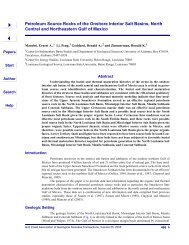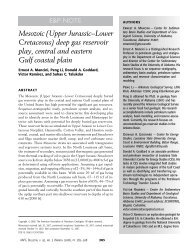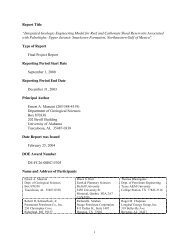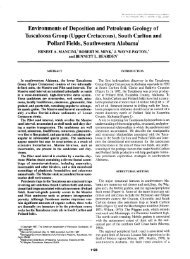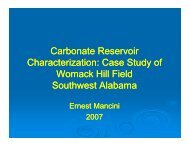Part 4 - Berg - Hughes Center
Part 4 - Berg - Hughes Center
Part 4 - Berg - Hughes Center
Create successful ePaper yourself
Turn your PDF publications into a flip-book with our unique Google optimized e-Paper software.
from the southern part of the basin and continued into the Tertiary. Present-day total<br />
organic carbon contents average 0.58% with original total organic contents probably<br />
averaging approximately 1%.<br />
Hydrocarbon expulsion and migration from Smackover source rocks in the North<br />
Louisiana Salt Basin commenced during the Early Cretaceous and continued into the<br />
Tertiary with peak expulsion mainly in the Early to Late Cretaceous. The hydrocarbon<br />
expulsion profiles for the wells are in agreement with the thermal maturation profiles.<br />
The timing of commencement of oil expulsion is consistent with the tectonic,<br />
depositional, burial and thermal histories of the basin. Hydrocarbon flow pathway<br />
modeling supports an intermediate range migration process for Smackover crude oil.<br />
Smackover hydrocarbon migration into overlying strata was facilitated by vertical<br />
migration along faults. Evans (1987), Sassen (1990) and Zimmerman and Sassen (1993)<br />
also published information in support of combined intermediate range and vertical<br />
hydrocarbon migration in this area. Smackover hydrocarbons migrated into Upper<br />
Jurassic, Cretaceous, and lower Tertiary sandstone and carbonate reservoirs. Upper<br />
Jurassic and Lower Cretaceous anhydrite and shale, Upper Cretaceous chalk and shale,<br />
and lower Tertiary shale acted as effective petroleum seal rocks.<br />
Hydrocarbons, mainly thermogenic gas, were generated from Upper Jurassic to<br />
Lower Cretaceous Bossier shale beds. The Type III kerogen in these beds is gas prone,<br />
and the total organic carbon content in this shale is low. These factors resulted in a<br />
saturation threshold that was not adequate to promote expulsion. Therefore, most of the<br />
gas generated probably was retained in the Bossier making this formation a potential gas<br />
shale reservoir.<br />
440




